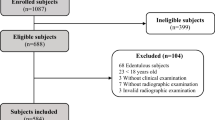Abstract
Apical periodontitis (AP) are frequent findings in contemporary dental practice in association with dental pathology or dental care. They have also been studied from an anthropological background. The purpose of this study was to compare the prevalence of apical and dental lesions in an archeological Middle Ages sample and a modern population, and to evaluate the influence of environmental factors. Both the archaeological sample group and dental practice subjects were from southern France. The study included full mouth surveys of 252 individuals (2,780 teeth) from a historic necropolis and 223 subjects (5,678 teeth) randomly selected from the Gard area. Tooth wear, caries, and AP were accounted for clinically and radiographically according to specific indexes. Significant differences were found between period and age in the archeological sample as regards the main risk factors for AP. Antemortem teeth loss and dental wear had been reduced, whereas caries rates and AP had increased between archaeological and modern population. The AP ratio was associated with the level of dental care in the modern population. Although significant variations could be observed between archaeological periods, the rupture in E3 (sixteenth and seventeenth centuries) leads to consider the associated population as a premodern. However, it was found that although cultural and alimentary factors seemed to be the main risk factors in an archeological population, dental care seemed to have a strong influence on AP ratio in modern ones.
Similar content being viewed by others
References
Alexandersen V (1967) The pathology of the jaws and the temporomandibular joint. In: Brothwell D, Sandison AT (eds) Disease in antiquity. Thomas, Springfield, pp 551–595
Alt KW, Turp JC, Wachter R (1998) Periapical lesions—clinical and anthropological aspects. In: Alt KW, Rosing FW, Teschler-Nicola M (eds) Dental anthropology. Springer, Berlin Heidelberg New York, pp 247–276
Boucher Y, Matossian L, Rilliard F, Machtou P (2002) Radiographic evaluation of the prevalence and technical quality of root canal treatment in a French subpopulation. Int Endod J 35:229–238
Brabant H (1962) Contribution à l’étude de la paléo-pathologie des dents et des maxillaires. La denture en Belgique à l’époque Néolithique. Bull Inst R Sci Nat Belg 38(6)
Clarke NG (1990) Periodontal defects of pulpal origin: evidence in early man. Am J Phys Anthropol 82:371–376
Clarke NG, Hirsh RS (1991) Physiological, pulpal and periodontal factors influencing alveolar bone. In: Kelley MA, Larsen CS (eds) Advances in dental anthropology. Wiley-Liss, New York, pp 241–266
Dias G, Tayles N (1997) ‘Abcess cavity’ a misnomer. Int J Osteoarchaeol 7:548–554
Duby G (1967) L’an Mil. Coll. ‘Archives’. Julliard, Paris
Elvery MW, Savage NW, Wood WB (1998) Radiographic study of the broadbeach aboriginal dentition. Am J Phys Anthropol 107:211–219
Eriksen HM (1991) Endodontology—epidemiologic considerations. Endod Dent Traumatol 7:189–195
Flandrin JL, Montarini M (1996) Histoire de l’alimentation. Fayard, Paris
Friedman S (1998) Treatment outcome and prognosis of endodontic therapy. In: Orstavik D, Pitt Ford TR (eds) Essential endodontology. Prevention and treatment of apical periodontitis. Blackwell Science, Oxford, pp 367–401
Hillson S (2001) Recording dental caries in archeological human remains. Int J Osteoarchaeol 11:249–289
Hoshino E, Ando N, Sato M, Kota K (1992) Bacterial invasion of non exposed dental pulp. Int Endod J 25:2–5
Hugoson A, Lundgren D, Asklow B, Borgklint G (2003) The effect of different dental health programmes on young adult individuals. A longitudinal evaluation of knowledge and behaviour including cost aspects. Swed Dent J 27(3):115–130
Kaifu Y (1999) Changes in the pattern of tooth wear from prehistoric to recent period in Japan. Am J Phys Anthropol 109:485–499
Kieser JA, Groeneveld HT, Preston CB (1985) Patterns of dental wear in the Lengua Indians of Paraguay. Am J Phys Anthropol 66:21–29
Kirkevang LL, Wenzel A (2003) Risk indicators for apical periodontitis. Community Dent Oral Epidemiol 31:59–67
Lauriou B (2002) Manger au Moyen-Age. La vie quotidienne. Hachette Littératures, Paris
Littlejohn J, Frohlich B (1993) Fish-eaters and farmers: dental pathology in the Arabian Gulf. Am J Phys Anthropol 92:427–447
Lukacs JR (1992) Dental paleopathology and agricultural intensification in South Asia: new evidence from Bronze Age Harappa. Am J Phys Anthropol 87:133–150
Luan WM, Baelum V, Chen X, Fejerskov O (1989) Dental caries in adult and elderly Chinese. J Dent Res 68:1771–1776
Maat GJR, Van der Velde EA (1987) The caries-attrition competition. Int J Anthropol 2:281–292
Masset C (1982) Estimation de l’âge au décès par les sutures crâniennes. Thèse de Sciences Naturelles, Paris VII, multigraphiée
Miles AEW (1963) The dentition in the assessment of individual age in skeletal material. Dental anthropology. Pergamon, Oxford 191–209
Molnar S (1971) Human tooth wear, tooth function and cultural variability. Am J Phys Anthropol 34:175–190
Molnar S (1971) Tooth wear and culture: a survey of tooth functions among some prehistoric populations. Curr Anthropol 13:511–515
Molnar S, Molnar I (1985) Observations of dental diseases among prehistoric populations of Hungary. Am J Phys Anthropol 67:51–63
Orstavik D, Kerekes K, Eriksen HM (1986) The periapical index: a scoring system for radiographic assessment of apical periodontitis. Endod Dent Traumatol 2:20–34
Ray HA, Trope M (1995) Periapical status of endodontically treated teeth in relation to the quality of the root filling and the coronal restoration. Int Endod J 28:12–18
Statshenko P (1998) Etiology and pathogenesis of pulpitis and apical periodontitis. In: Orstravik D, Pitt Ford TR (eds) Essential endodontology. Prevention and treatment of apical periodontitis. Blackwell, Oxford, pp 42–67
Taylor RMS (1975) Significance of tooth wear in Polynesians. J Dent Assoc S Afr 30:241–244
Ungar PS, Simons JC, Cooper JW (1991) A semiautomated image analysis procedure for the quantification of dental microwear. Scanning 13:31–36
Walker A (1981) Diet and teeth: dietary hypothesis and human evolution. Philos Trans R Soc Lond 292:57–64
Whitworth JM (2000) Apparent periapical repair without operative intervention: a case report and discussion. Int Endod J 33:286–289
Author information
Authors and Affiliations
Corresponding author
Rights and permissions
About this article
Cite this article
Chazel, JC., Valcarcel, J., Tramini, P. et al. Coronal and apical lesions, environmental factors: study in a modern and an archeological population. Clin Oral Invest 9, 197–202 (2005). https://doi.org/10.1007/s00784-005-0318-3
Received:
Accepted:
Published:
Issue Date:
DOI: https://doi.org/10.1007/s00784-005-0318-3



